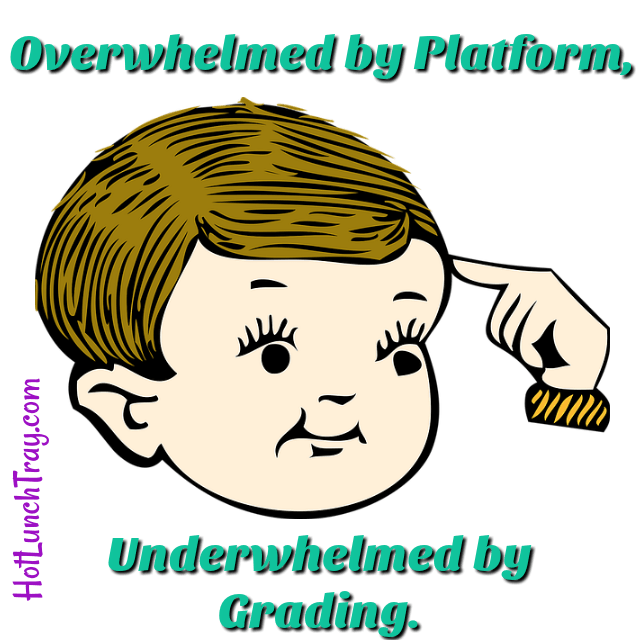This is no longer the days of create-everything-from-scratch with some scissors, tape, and a copy machine. Multiple websites promise to be your educational platform and grading program of choice. There are seemingly limitless resources out there for educators to access… seemingly.. endless.
In fact, maybe there are too many good resources.
Overwhelmed by Platform, Underwhelmed by Grading
Where I was overwhelmed by the enormity of creating content, I am now overwhelmed by all the possible content I could use. I experience the fear of missing out on the newest platform, so I dedicate time to research. And I pick the best content from all these different places and platforms and try to bring them together in an ever-evolving dance involving HTML, embed codes, secure URLs, and a stubborn Super Glue mentality.
Platform
Content is fresh and new from varied providers. The new waves of providers are not so much the issue as how they promote their content for use inside their platform.
Everyone has their own Learning Management System (LMS), and whatever it is, it likely does not play well with your LMS.
In the current growing world of #EdTech new platforms are inevitable, the predictable tedious task of figuring out how to incorporate disparate resources is a given. And the likelihood of any one platform having both easy to use resources and an easily exportable grading system is nil. But a strategy on how to approach this current environment is a unenforced, sometime unmentioned, requirement for teacher sanity.
Teachers have two choices:
Embrace a sparse unity.
Work really hard, all the time to keep these resources together.
I opt for the former. Unifying resources and grades into the smallest number of places possible is my preferred answer. I look for one home base and then see which home base would give me the most flexibility in bringing together content and harvesting grades.
Grading
And when it is time to bringing grades together from this disparate places, the stress escalates. Grading is an inverse, yet more urgent and high stakes event than gathering content. #EdTech startup platforms appear to place less attention on the portability, conformity/transparency of a grading system to the frustration of teachers. While it is likely teachers are given a grading system by their school or district. And since that official gradebook was likely there before a good many current teachers started work, what can you do to influence it anyway?
- Make sure all stakeholders know the official gradebook
- Do not allow your content platform to display any grade averages lightly
Not all gradebooks calculate the same. And before you suspect I have major math impairments; some gradebooks round to the nearest tenth other round to the nearest hundredth. You do not want to provide false grades to students and/or their families.
Also, the majority of classrooms practice Blended Learning over Online Learning. Any partial gradebook, which only represents some grades is never the best one to put on display.
Which is More Important: Platform or Grading?

That’s right, both. Grades are the currency of most schools right now and the path to higher education for most of our current students. But educators really care about the content, and the why and how which result in grades. Make sure you fully understand the difference between a LMS and a Student Information System (SIS).
Content platforms and grading systems which talk to each other are preferable, but are problematic to successfully join. They are two different generations of software solutions and have typical May-December problems. Of course it would be ideal if one system talked to another and vice versa. And as more new generation platforms make their APIs public, the possibility exist
s for the grading systems to work one-on-one with that API. Promising advances like One Roster offer a secure channel for some porting of information between systems. But the discussion will quickly become which system dominates – grading or platform?
If these systems do not talk, get realistic about what you have influence over. You have influence over where you point your students and their families for which purpose. Be intentional upfront about where to find and submit course content and where to find (official) grades. Be mindful that if a classroom policy is good, a grade level/department policy is better, and a school policy is best.
While it has been a minute since I used scissors, tape and white-out in the copy room I know that teachers will make things work – some of the craziest things! But as educators, we can be intentional of what we demand in products we purchase, how we communicate to our stakeholders about disparate systems, and how we let the purchasers in our schools and districts know about this real struggle between content delivery and grade recording.





1 Pingback